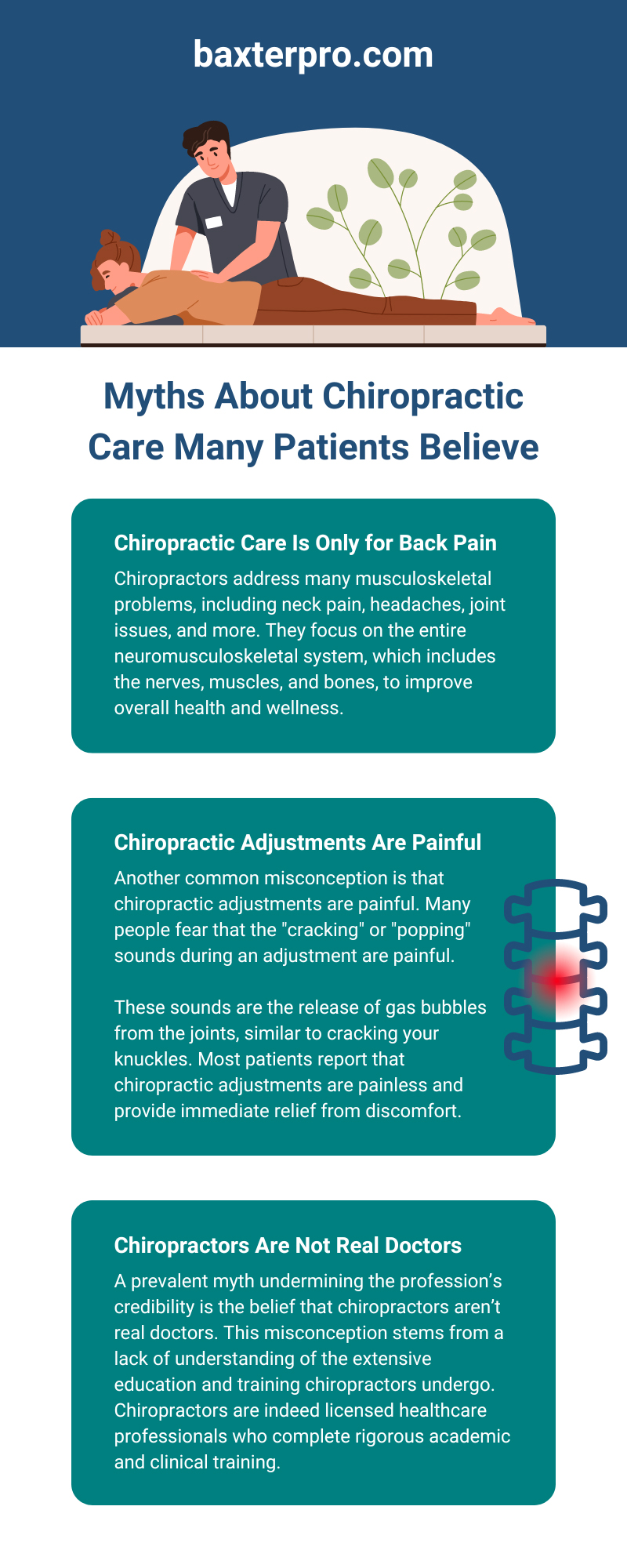
9 Myths About Chiropractic Care Many Patients Believe
Oct 03 2024Chiropractic care remains a misunderstood field, even as more people seek alternatives to traditional medicine. Misconceptions about what chiropractors do and how they help patients continue to spread, often deterring individuals from pursuing this effective form of treatment.
Understanding and addressing these myths is crucial for chiropractic offices to provide clarity and reassurance to their patients. Let’s explore some of the most common myths about chiropractic care many patients believe and discuss the facts that dispel these misconceptions.
Myth 1: Chiropractic Care Is Only for Back Pain
One longstanding myth about chiropractic care is that it’s only for helping people treat back pain. While chiropractors often help patients with back issues, the scope of chiropractic care is much broader.
Chiropractors address many musculoskeletal problems, including neck pain, headaches, joint issues, and more. They focus on the entire neuromusculoskeletal system, which includes the nerves, muscles, and bones, to improve overall health and wellness.
Myth 2: Chiropractic Adjustments Are Painful
Another common misconception is that chiropractic adjustments are painful. Many people fear that the “cracking” or “popping” sounds during an adjustment are painful.
These sounds are the release of gas bubbles from the joints, similar to cracking your knuckles. Most patients report that chiropractic adjustments are painless and provide immediate relief from discomfort.
Chiropractors use various techniques to make adjustments as comfortable as possible. They consider each patient’s unique condition and tolerance levels, customizing their approach accordingly.
Chiropractors also provide guidance on post-adjustment care to enhance the benefits and minimize any discomfort. Understanding the reality behind this myth can help patients approach chiropractic care with confidence and ease.
Myth 3: Chiropractors Are Not Real Doctors
A prevalent myth undermining the profession’s credibility is the belief that chiropractors aren’t real doctors. This misconception stems from a lack of understanding of the extensive education and training chiropractors undergo. Chiropractors are indeed licensed healthcare professionals who complete rigorous academic and clinical training.
Before receiving their license, chiropractors must earn a Doctor of Chiropractic (D.C.) degree from an accredited chiropractic college. This education usually involves at least seven years of post-secondary education, including courses in anatomy, physiology, neurology, and diagnostic imaging. Additionally, chiropractors must pass national board exams and meet state-specific licensing requirements, making them qualified and trusted healthcare providers.
Myth 4: Chiropractic Care Is Not Safe
Safety concerns often arise when patients are unfamiliar with chiropractic care, leading to the myth that treatment is unsafe. Adverse effects from chiropractic adjustments are rare and usually minor, such as temporary soreness or stiffness. Chiropractors always conduct thorough assessments of each patient before beginning treatment, allowing them to determine the appropriate treatments for the patient’s condition.
They also review a patient’s medical history, perform physical exams, and use diagnostic imaging when necessary to rule out any contraindications. By emphasizing the safety of chiropractic care, practitioners can help alleviate patient fears and encourage more people to seek the benefits of this non-invasive treatment.
Myth 5: Chiropractic Care Is Too Expensive
The perception that chiropractic care is prohibitively expensive is another myth that can deter patients from seeking treatment. While healthcare costs are a concern for many, chiropractic care is often more affordable than other medical treatments, especially when considering the long-term benefits and prevention of more costly medical interventions. Many insurance plans, including Medicare, cover chiropractic services, making it accessible to a broader range of patients.
Moreover, investing in chiropractic care can lead to significant savings by reducing the need for expensive medications, surgeries, or other treatments. Educating patients about the cost-effectiveness of chiropractic care can help dispel this myth and encourage them to prioritize their health.
Myth 6: Chiropractic Care Is a Never-Ending Cycle
A common concern among patients is the belief that once they start seeing a chiropractor, they will need to continue treatment for the rest of their lives. This myth stems from a misunderstanding of how chiropractic care works and its goals. While some patients may benefit from ongoing care, most treatment plans serve the individual’s needs and will address specific issues within a reasonable timeframe.
Chiropractors work with patients to develop personalized treatment plans that include a clear end goal, such as pain relief, improved mobility, or enhanced overall health. Once the patient achieves these goals, the chiropractor may recommend maintenance visits at intervals that support long-term health, but these aren’t mandatory. The decision to continue care is always up to the patient.
Myth 7: Chiropractors Only Provide Temporary Relief
Some patients believe that chiropractic care only offers temporary relief and doesn’t address the root cause of their condition. This myth arises from a misunderstanding of how chiropractic care works. Chiropractors focus on restoring proper alignment and function to the body, which can have long-lasting effects when combined with lifestyle changes and patient education.
Chiropractors also emphasize the importance of addressing underlying issues, such as poor posture, muscle imbalances, or repetitive strain injuries, to prevent recurring problems. They provide patients with exercises, stretches, and ergonomic advice to support their recovery and maintain long-term health. Understanding that chiropractic care can offer lasting relief and promote overall wellness helps debunk the myth of temporary benefits.
Myth 8: Chiropractic Care Is Only for Adults
The belief that chiropractic care is only for adults is another common myth that limits the potential benefits for younger patients. Chiropractic care is suitable for people of all ages, including infants, children, and adolescents. Chiropractors can adjust their techniques to accommodate the specific needs of younger patients, maintaining safe and effective treatment.
Pediatric chiropractic care can help address several issues, such as colic, ear infections, and scoliosis. Early intervention through chiropractic adjustments can also support proper growth and development, helping children avoid future musculoskeletal problems. By educating parents about the benefits of chiropractic care for their children, chiropractors can help dispel the myth that their services are only for adults.
Myth 9: You Should Only See a Chiropractor When You’re in Pain
Many people believe that chiropractic care is only necessary when they’re in pain. However, this myth overlooks the preventive aspect of chiropractic treatment. Regular chiropractic adjustments can help maintain proper alignment, prevent injuries, and support overall health, even when the patient isn’t experiencing pain.
Chiropractors can identify and address potential issues before they become painful, such as misalignments, joint restrictions, or muscle imbalances. By promoting regular chiropractic care as part of a wellness routine, practitioners can help patients understand the value of preventive care and dispel the myth that chiropractic treatment is only for pain management.
Understanding and dispelling the myths about chiropractic care that many patients believe is essential for practitioners to build trust with their patients. As chiropractic offices continue to dispel these myths, they also need to protect their practices with the right insurance coverage. You can find the right chiropractic liability insurance for your practice with the help of Baxter & Associates. Contact us today for more info!




